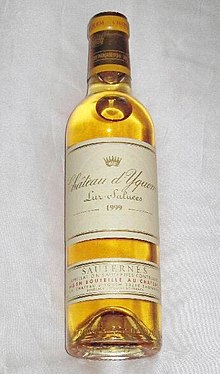Sauternes (wine)
Sauternes wine is made from Sémillon, sauvignon blanc, and muscadelle grapes that have been affected by Botrytis cinerea, also known as noble rot.Wines from Sauternes, especially the Premier Cru Supérieur estate Château d'Yquem, can be very expensive, largely due to the very high cost of production.While the English had been the region's primary export market since the Middle Ages, their tastes primarily ran to drier wines, starting with clairet in medieval times and eventually shifting to red claret.They introduced to the region German white wine making techniques, such as halting fermentation with the use of sulphur in order to maintain residual sugar levels.Being an anti-microbial agent, sulphur stuns the yeast that stimulates fermentation, eventually bringing it to a halt with high levels of sugars still in the wine.It seems that at this point the "unspoken secret" was more widely accepted and the reputation of Sauternes rose to rival those of the German and Hungarian dessert wines.[5] Jefferson recorded that after tasting a sample of Château d'Yquem while President, George Washington immediately placed an order for 30 dozen bottles.In the autumn, when the climate is warm and dry, the different temperatures from the two rivers meet to produce mist that descends upon the vineyards from evening to late morning.[7] Among the outstanding wineries in the Sauternes region, it is worth mentioning the Château d'Yquem, the Guiraud, the Filhot, the Rayne-Vigneau, the Climens, the Coutet, and La Tour Blanche.



Frenchsweet wineGravesBordeauxSémillonsauvignon blancmuscadellegrapesBotrytis cinereanoble rotraisinedclimatewine regionsharvestsvintageChâteau d'YquemBarsacMonbazillacCéronsLoupiacCadillacsemi-genericviticultureAquitaniaRomansEnglishMiddle AgesclairetclaretGerman winesGermanyThirty Years' Warfermentationsulphurresidual sugarcandleHugh JohnsonwinemakingTokajiHungarianThomas JeffersonPresidentGeorge Washingtonmaritime climateGaronnetributaryspringcommunesBommesFarguesPreignacappellationalluvialBordeaux AOCalcohol levelapricotspeachesfinishcopperhalf bottlesserved chilledpairedFoie grasOxford University PressAnnual growth cycle of grapevinesOenologyTerroirVeraisonVineyardHistoryPhoeniciansAncient GreeceAncient RomeNoah's wineFranceGreat French Wine BlightNew WorldJudgment of ParisSparklingOrangeDessertFortifiedAromatizedNaturalBiodynamicOrganicKoshergrape varietiesAirénAligotéCatarrattoCayetana blancaChardonnayChenin blancColombardGrüner VeltlinerMacabeoMüller-ThurgauMuscat blancMuscat of AlexandriaPalominoRieslingRkatsiteliTrebbianoWelschrieslingAlicante BouschetBarberaCabernet FrancCabernet SauvignonCarignanCinsautDouce noirGrenacheIsabellaMalbecMerlotMontepulcianoMourvèdrePinot noirSangioveseTempranilloZinfandelMajor regionsOld Worldaccessoriesstorage